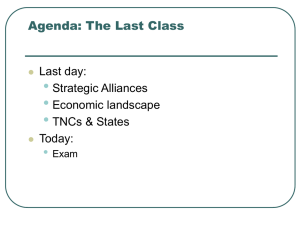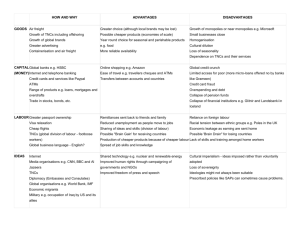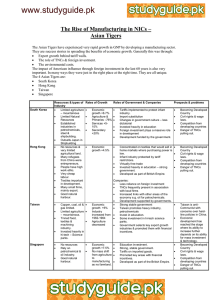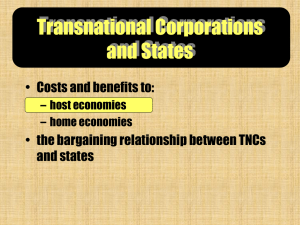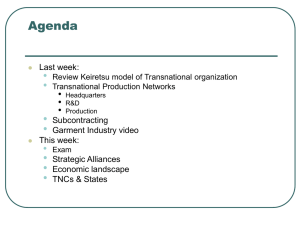INVESTMENT BY SOUTH TNCs REACHED A RECORD LEVEL
advertisement
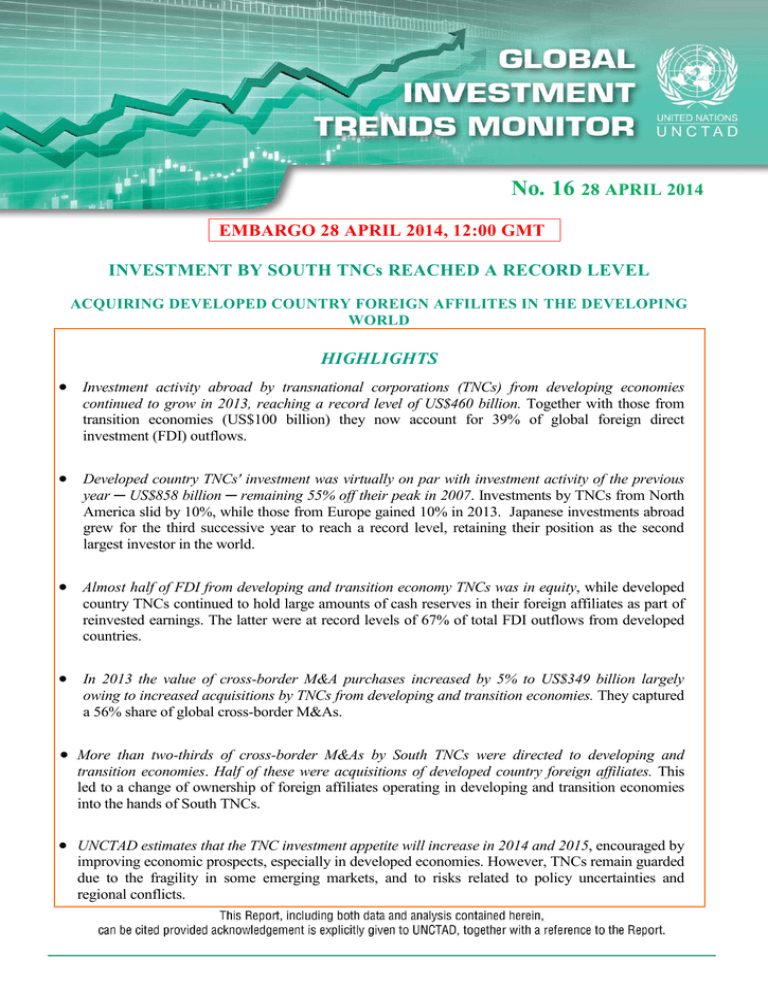
No. 16 28 APRIL 2014 EMBARGO 28 APRIL 2014, 12:00 GMT INVESTMENT BY SOUTH TNCs REACHED A RECORD LEVEL ACQUIRING DEVELOPED COUNTRY FOREIGN AFFILITES IN THE DEVELOPING WORLD HIGHLIGHTS Investment activity abroad by transnational corporations (TNCs) from developing economies continued to grow in 2013, reaching a record level of US$460 billion. Together with those from transition economies (US$100 billion) they now account for 39% of global foreign direct investment (FDI) outflows. Developed country TNCs' investment was virtually on par with investment activity of the previous year ─ US$858 billion ─ remaining 55% off their peak in 2007. Investments by TNCs from North America slid by 10%, while those from Europe gained 10% in 2013. Japanese investments abroad grew for the third successive year to reach a record level, retaining their position as the second largest investor in the world. Almost half of FDI from developing and transition economy TNCs was in equity, while developed country TNCs continued to hold large amounts of cash reserves in their foreign affiliates as part of reinvested earnings. The latter were at record levels of 67% of total FDI outflows from developed countries. In 2013 the value of cross-border M&A purchases increased by 5% to US$349 billion largely owing to increased acquisitions by TNCs from developing and transition economies. They captured a 56% share of global cross-border M&As. More than two-thirds of cross-border M&As by South TNCs were directed to developing and transition economies. Half of these were acquisitions of developed country foreign affiliates. This led to a change of ownership of foreign affiliates operating in developing and transition economies into the hands of South TNCs. UNCTAD estimates that the TNC investment appetite will increase in 2014 and 2015, encouraged by improving economic prospects, especially in developed economies. However, TNCs remain guarded due to the fragility in some emerging markets, and to risks related to policy uncertainties and regional conflicts. In 2013, investors from developing and transition economies continued their expansion abroad, due to faster economic growth and investment liberalization – as well as rising income streams from high level of commodity prices. In 2013 they accounted for 39% of world outflows; 15 years ago that share was only 12% (figure 1). In contrast, TNCs from the North continued their wait and see approach with investments remaining at a similar low level of 2012. Figure 1. The share of FDI outflows by group of economies, 1999–2013 (Per cent) 88% 61% 39% 12% Source: UNCTAD. Almost half of FDI from developing and transition economy TNCs was in equity, while developed country TNCs continued to hold large amounts of cash reserves in their foreign affiliates in the form of retained earnings, which constitutes part of reinvested earnings, one of the components of FDI flows. This component was at a record level of 67% (figure 2). Figure 2. The distribution of FDI outflows by component, by group of TNCs, 2007– 2013 (Per cent) a Developed country TNCs b Developing and transition economy TNCs Source: UNCTAD. a Economies included are: Belgium, Bulgaria, Czech Republic, Denmark, Estonia, Germany, Hungary, Japan, Latvia, Lithuania, Luxembourg, Netherlands, Norway, Poland, Portugal, Sweden, Switzerland, United Kingdom and the United States. b Economies included are: Albania, Algeria, Antigua and Barbuda, Armenia, Belarus, B elize, Plurinational State of Bolivia , Brazil, Chile, Colombia, Dominica, El Salvador, Georgia, Grenada, Guatemala, Hong Kong (China), India, Indonesia, Kazakhstan, Lesotho, Libya, Mongolia , Montenegro, Namibia, Nicaragua, Nigeria, Pakistan, Philippines, Republic of Moldova, Saint Kitts and Nevis, Saint Lucia, Saint Vincent and the Grenadines, Serbia, Taiwan Province of China, TFYR of Macedonia, Thailand, Ukraine and Uruguay. Investments from developed country TNCs continue to stagnate … Investment levels of TNCs from developed countries were unchanged from 2012 ─ at US$858 billion ─ and still 55% off their peak in 2007. Their share in global FDI outflows reached a historically low level of 61% (figure 1) Investments from the largest investor ─ the United States ─ dropped by 8% to US$338 billion, despite the growing level of reinvested earnings abroad. FDI outflows from the EU rose by 6% to US$252 billion; those from Europe as a whole increased by 10% to US$330 billion. With US$60 billion Switzerland became the largest outward investor in Europe, propelled by a doubling of reinvested earnings abroad. Countries that recorded a large decline in 2012, including Italy, the Netherlands and Spain, saw their outflows rebound sharply. In contrast, investments by TNCs from France, Germany and the United Kingdom saw a substantial decline, falling by US$40 billion (to -US$2.6 billion), US$22 billion (to US$58 billion), and US$16 billion (to US$19 billion), respectively. TNCs from France and the United Kingdom undertook significant equity divestment abroad. Despite the substantial depreciation of the currency, investments from Japanese TNCs continued to expand, rising by over 10% (or by almost 40% in local currency terms) to a record US$135 billion. This growth is largely accounted for by increases in equity. Reinvested earnings of Japanese TNCs were relatively small (14% of the total) and actually declined in 2013. ... while developing country investors remain resilient Investment activity by TNCs from the South increased by 4% in 2013, advancing to a record level of US$460 billion. Among developing regions, Asian and African TNCs increased their investment abroad, while those from Latin America and the Caribbean reduced theirs. Asian TNCs remained a large source of FDI, accounting for more than one fifth of the world's total. In 2013, investment flows from developing Asia rose by 7% to US$327 billion with diverging trends among sub-regions: East and South-East Asia TNCs experienced growth of 7% and 2%, respectively; investment from West Asia surged by almost two thirds; and TNC activities from South Asia slid by nearly three-quarters (table 1). In East Asia, investment from Chinese TNCs climbed by 15% to an estimated US$101 billion due to a surge of cross-border merger and acquisitions (M&As) (examples include the US$19 billion CNOOC-Nexen deal in Canada and the US$5 billion ShuanghuiSmithfield Foods deal in the United States ─ so far the largest overseas deals made by Chinese firms in oil and gas and food industries respectively). In the meantime, investors from Hong Kong (China) grew by 4% to US$92 billion. The two East Asian economies have consolidated their positions as the leading sources of FDI in the world (figure 3). Investment flows from the two other important sources in East Asia: ─ the Republic of Korea and Taiwan Province of China ─ showed contrasting trends: those by TNCs from the former declined by 7% to US$31 billion, while investments by TNCs from the latter rose by 9% to US$14 billion. Table 1. FDI outflows, by region and major economy, 2011–2013 (Billions of US dollars) Region / Economy World Developed economies Europe European Union United States Japan Developing economies Africa North Africa Other Africa Latin America and the Caribbean South America Central America Caribbean Developing Asia West Asia East Asia South Asia South-East Asia Transition economies 2011 1709 1215 653 585 387 108 420 5 2 4 110 28 13 69 304 22 213 13 56 74 2012a 1349 853 300 238 367 123 443 13 3 10 124 22 23 79 305 19 222 9 54 54 2013b 1418 858 330 252 338 135 460 21 6 15 112 18 11 83 327 32 238 2 55 100 Growth rate 2012–2013 (%) 5.1 0.6 10.3 5.9 -7.8 10.3 4.0 57.1 76.5 50.7 -9.7 -18.9 -52.9 5.3 7.4 64.6 6.9 -73.8 2.1 85.2 Source : UNCTAD. The data can be cited provided acnowledgement is explicitly given to UNCTAD. a Revised. b Estimated. Note : World FDI outflows are projected on the basis of 132 economies for which data are available for the full year or part of 2013, as of 9 April 2014. Data are estimated by annualizing their available data, in most cases the first three quarters of 2013. The proportion of outflows from these economies to total outflows from their respective region or subregion in 2012 is used to extrapolate the 2013 regional data. Investments by South-East Asia TNCs increased by 2% in 2013, with the doubling of investment from Singapore ─ the sub-region's leading investor ─ offset by declines of investments from Malaysia (-21% to US$14 billion) and Thailand (-49% to US$7 billion). In South Asia, Indian TNCs reduced their activities by three-quarters to US$2 billion (back at levels last seen in 2002). Investments by TNCs in West Asia increased by 65% in 2013 boosted by rising flows from the GCC countries. Although each of these countries augmented its investment abroad, souring FDI by TNCs from Qatar (more than quadrupling) and Kuwait (159%), explained most of the increase. Investments from Africa leapt by 57% in 2013, mainly on the back of investment flows from South Africa and Nigeria. South African TNCs invested in telecommunications, mining and retail while those from Nigeria focused largely on financial services. Intra-African investments rose significantly during the year. Figure 3. Top 20 investors, 2013 (Billions of US dollars) 338 Source: UNCTAD. TNCs from Latin America and the Caribbean decreased their investments abroad in 2013 by 10% to US$112 billion, mainly on account of a 36% drop in investments from Central and South America. The fall of investment from this sub-region was largely attributable to a decline in cross-border M&As and a strong increase in loan repayments to parent companies by Brazilian and Chilean foreign affiliates abroad. Colombian TNCs, in contrast, bucked the region's declining trend and more than doubled their cross-border M&As in industries such as energy, food, banks and cement. Investments from TNCs registered in Caribbean countries ─ mainly in two offshore financial centres, the British Virgin Islands and Cayman Islands ─ increased by 5% in 2013, constituting about three-quarters of the region's total investments abroad. In 2013 investments by TNCs based in transition economies increased by 85%, reaching US$100 billion. Most FDI projects, as in the past years, were carried out by Russian TNCs followed by those from Kazakhstan and Azerbaijan. The value of cross-border M&A purchases by TNCs from the region rose more than seven times, mainly as a result of the acquisition of TNK-BP Ltd (British Virgin Island) by Rosneft, even though the number of cross-border M&A deals dropped in 2013 compared to 2012. Announced greenfield investments also rose, by 87%, to US$19 billion. South TNCs acquired significant assets of developed country foreign affiliates in the developing world In 2013 the value of cross-border M&A purchases increased marginally by 5% to US$349 billion largely on the back of increased investment flows from developing and transition economies, whose TNCs captured a 56% share of global acquisitions. The global rankings of the largest investor countries in terms of cross-border M&As reflect this pattern. For example, among the top 20 cross-border M&A investors, 12 are from developing and transition economies ─ seven more that in the case of FDI outflows. During 2013, investors from developed countries retreated from extractive industries and reduced M&A purchases in trade, hotels, restaurants, transport services and in all manufacturing industries. Developed country TNCs increased their purchases only in select industries such as the telecommunication and information sector, and business services (the mega deal of Japan's telecom company Softbank acquiring United States-based Sprint Nextel, for over US$21 billion illustrates confidence remains strong in the telecommunications industry). In contrast, TNCs based in developing and transition economies were drawn to consumer sectors. In particular, they continued to scale up investment in food and beverages, building materials, utilities, hotels and restaurants, business services and finance services. One of the most notable deals in the consumer industry was the above-noted purchase by Shuanghui (China’s largest pork producer) of United Statesbased Smithfield Foods. More than two-thirds of gross cross-border M&As by South TNCs were directed to developing and transition economies (figure 4). Half of these investments involved developed country foreign affiliates in developing and transition economies. This led to a change of ownership of foreign affiliates operating in developing and transition economies into the hands of developing country TNCs. This trend was particularly marked in the extractive industry, where the value of transactions involving developed country TNCs' sales to developing counterparts represented over 80% of South-based TNCs' gross acquisitions in the sector and in Africa as a whole (74% of purchases on the continent). The leading acquirers in South-South deals were China, followed by Thailand, Hong Kong (China), Mexico and India. Examples of this trend include several mega deals such as the Italian oil and gas group ENI Spa's sale of its subsidiary in Mozambique to PetroChina Co Ltd for over US$4 billion; the oil and gas group Apache Corp's sale of its subsidiary in Egypt to Chinese Sinopec for almost US$3 billion; and ConocoPhillips's sale of its affiliates in Algeria to an Indonesian state-owned company Pertamina PT for US$1.8 billion. The banking industry followed the same pattern: for example in Colombia, Bancolombia SA acquired the entire share capital of HSBC Bank (Panama) from HSBC (United Kingdom) for US$2.1 billion; and in Egypt, Qatar National Bank (Qatar), a majority-owned unit of the Qatar state-owned Qatar Investment Authority, acquired a 77% stake of Cairo-based National Société Générale Bank SAE, from Société Générale (France) for US$ 1.97 billion. Figure 4. Distribution of gross cross-border M&As purchases by developing and transition economy-based TNCs, 2013 (Per cent) Source: UNCTAD. Note: "Gross" refer to all cross-border M&As. Cross-border M&As reported by UNCTAD is on a "net" basis which takes into account divestments. Better investment conditions in 2014 and 2015 With global economic prospects improved and business risks reduced, UNCTAD estimates that investments by TNCs will rise in 2014 and 2015. The financial market rally and increased corporate profits in 2013 might support their confidence to invest. Strong cross-border M&A activity in the first quarter of 2014 suggests that at least equity investment − part of FDI flows − will rise in 2014, especially from developed country TNCs. However, the economic recovery is still uneven, with improving economic prospects in the United States and Japan on the one hand, and weaker growth in the EU and some emerging markets on the other. In addition, risks persist, related in particular to policy uncertainties and regional conflict. UNCTAD World Investment Forum will take place in Geneva, 13-16 October 2014 Registration: http://unctad-worldinvestmentforum.org TheThe nextnext issue issue of UNCTAD’s of UNCTAD’s Global Global Investment Investment Trends Trends Monitor Monitor willwill be be released released in mid-April in mid-October 2014. 2014. The Detailed next issue and individual of UNCTAD’s region/country Investment data Policyfor Monitor 2013 will be available will be released only in in thelate World February Investment 2014. Report 2014 scheduled to be released on 24 June 2014.



